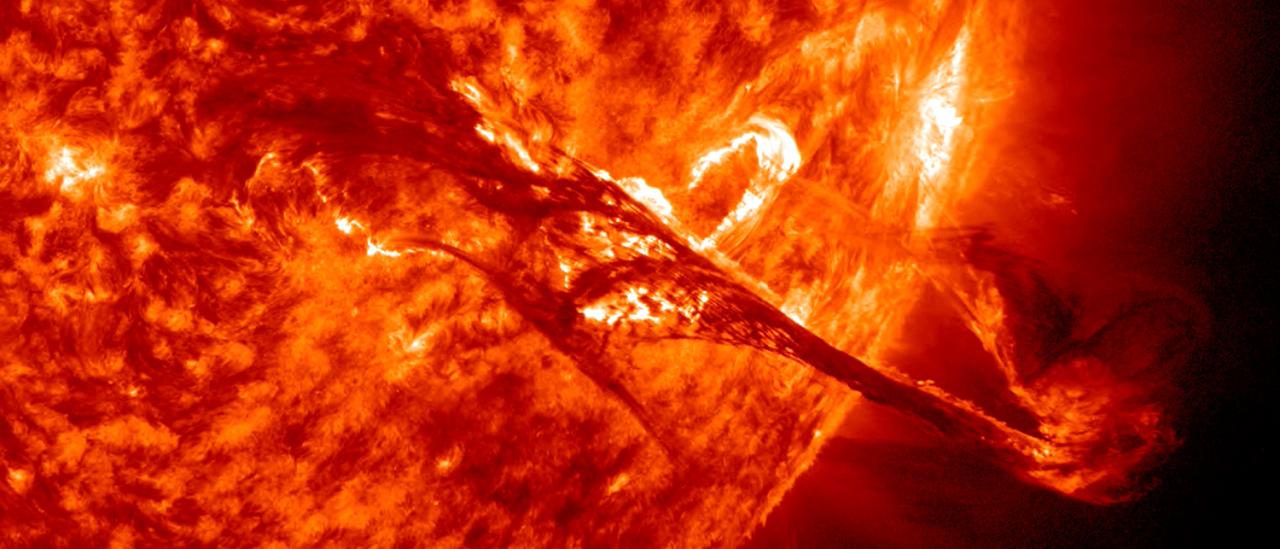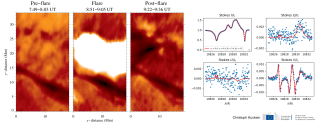Subvenciones relacionadas:
General
Los campos magnéticos son uno de los ingredientes fundamentales en la formación de estrellas y su evolución. En el nacimiento de una estrella, los campos magnéticos llegan a frenar su rotación durante el colapso de la nube molecular, y en el fin de la vida de una estrella, el magnetismo puede ser clave en la forma en la que se pierden las capas externas de forma dramática. En la vida adulta, el magnetismo da lugar a la actividad de las estrellas. Nuestro Sol tiene campos magnéticos que dan lugar a una actividad tan espectacular que es capaz de tener un impacto en la Tierra. Pero en otras estrellas, la actividad magnética es, en algunos casos, órdenes de magnitud más intensa que la solar, influenciando drásticamente el transporte de especies químicas y de momento angular, así como afectando posibles sistemas planetarios alrededor de éstas.
La finalidad de este Proyecto es estudiar diversas manifestaciones del campo magnético que se pueden observar en la atmosfera solar y en otras estrellas. Estas incluyen estructuras tan diversas como las manchas solares, los campos débiles presentes en el sol en calma o estructuras cromosféricas y coronales como los filamentos y las protuberancias. Así, se han ido abordando gradualmente los siguientes temas de investigación:
Magnetismo solar
- Estructura y evolución del campo magnético en manchas solares.
- Estructura y evolución del campo magnético en el Sol en calma.
- Estructura y evolución del campo magnético en la cromosfera y en estructuras cromosféricas (protuberancias, espículas,...)
- Estructura y evolución del campo magnético en bucles coronales.
- Estructura y evolución del campo magnético global del Sol. Estudios del ciclo de actividad magnética.
- Estudio empírico de la propagación de ondas magnetohidrodinámicas en el seno de estructuras magnéticas.
- Estudio empírico de mecanismos relacionados con el calentamiento de las capas externas del Sol.
- Estudio empírico de la influencia de la ionización parcial en la dinamica de la atmosfera solar.
- Implicación en el proyecto del Telescopio Solar Europeo.
Magnetismo estelar
- Desarrollo de métodos numéricos para el diagnóstico del campo magnético estelar, tanto en la superficie como en la cromosfera.
- Estudio del magnetismo en protuberancias estelares.
- Impacto del campo magnético en las últimas fases de la evolución estelar.
Miembros
Resultados
- Ondas espirales en manchas solares: Se han interpretado como ondas magnetoacústicas que se propagan desde el interior hasta capas atmosféricas siguiendo la dirección del campo magnético. Se ha caracterizado la topología del campo magnético de la mancha, descartando que la forma espiral sea consecuencia del retorcimiento de las líneas de campo (Felipe et al. 2019).
- Respuesta magnética a umbral flashes: Observaciones espectropolarimétricas simultáneas de las líneas cromosféricas He I 10830 y Ca II 8542 fueron usadas para estimar las fluctuaciones del campo magnético asociado a ondas de choque. Los choques provocan la expansión de las líneas de campo (Houston et al. 2018, incluye a A. Asensio Ramos).
Actividad científica
Publicaciones relacionadas
-
Photospheric magnetic topology of a north polar region
Aims: We aim to characterise the magnetism of a large fraction of the north polar region close to a maximum of activity, when the polar regions are reversing their dominant polarity. Methods: We make use of full spectropolarimetric data from the CRisp Imaging Spectro-Polarimeter installed at the Swedish Solar Telescope. The data consist of a
Pastor Yabar, A. et al.Fecha de publicación:
32020 -
Evolution of Stokes V area asymmetry related to a quiet Sun cancellation observed with GRIS/IFU
A quiet Sun magnetic flux cancellation event at the disk center was recorded using the Integral Field Unit (IFU) mounted on the GREGOR Infrared Spectrograph (GRIS). The GRIS instrument sampled the event in the photospheric Si I 10827 Å spectral line. The cancellation was preceded by a significant rise in line core intensity and excitation
Kaithakkal, A. J. et al.Fecha de publicación:
22020 -
Tracking Downflows from the Chromosphere to the Photosphere in a Solar Arch Filament System
We study the dynamics of plasma along the legs of an arch filament system (AFS) from the chromosphere to the photosphere, observed with high-cadence spectroscopic data from two ground-based solar telescopes: the GREGOR telescope (Tenerife) using the GREGOR Infrared Spectrograph in the He i 10830 Å range and the Swedish Solar Telescope (La Palma)
González Manrique, Sergio Javier et al.Fecha de publicación:
22020 -
Two-dimensional simulations of coronal rain dynamics. I. Model consisting of a vertical magnetic field and an unbounded atmosphere
Context. Coronal rain often comes about as the final product of evaporation and condensation cycles that occur in active regions. Observations show that the condensed plasma falls with an acceleration that is less than that of free fall. Aims: We aim to improve the understanding of the physical mechanisms behind the slower than free-fall motion and
Martínez-Gómez, D. et al.Fecha de publicación:
22020 -
Capabilities of bisector analysis of the Si I 10 827 Å line for estimating line-of-sight velocities in the quiet Sun
We examine the capabilities of a fast and simple method to infer line-of-sight (LOS) velocities from observations of the photospheric Si I 10 827 Å line. This spectral line is routinely observed together with the chromospheric He I 10 830 Å triplet as it helps to constrain the atmospheric parameters. We study the accuracy of bisector analysis and a
González Manrique, S. J. et al.Fecha de publicación:
22020 -
Spectro-polarimetric analysis of a short lived solar active region
The physical processes related to the formation, evolution and disappearance of solar active regions are not completely clear. High-resolution solar spectro-polarimetric data are needed to investigate these processes with unprecedented details. Here we present the analysis of the short-lived NOAA 12549 active region using high-resolution spectro
Viavattene, G. et al.Fecha de publicación:
12019 -
An introductory guide to fluid models with anisotropic temperatures. Part 1. CGL description and collisionless fluid hierarchy
We present a detailed guide to advanced collisionless fluid models that incorporate kinetic effects into the fluid framework, and that are much closer to the collisionless kinetic description than traditional magnetohydrodynamics. Such fluid models are directly applicable to modelling the turbulent evolution of a vast array of astrophysical plasmas
Hunana, P. et al.Fecha de publicación:
122019 -
An introductory guide to fluid models with anisotropic temperatures. Part 2. Kinetic theory, Padé approximants and Landau fluid closures
In Part 2 of our guide to collisionless fluid models, we concentrate on Landau fluid closures. These closures were pioneered by Hammett and Perkins and allow for the rigorous incorporation of collisionless Landau damping into a fluid framework. It is Landau damping that sharply separates traditional fluid models and collisionless kinetic theory
Hunana, P. et al.Fecha de publicación:
122019 -
Fast-to-Alfvén Mode Conversion and Ambipolar Heating in Structured Media. I. Simplified Cold Plasma Model
Linear fast magnetoacoustic waves are introduced into a cold stratified plasma model made up of a doubly periodic ensemble of straight diminished-Alfvén-speed tubes. Coupling between fast and Alfvén waves is produced by stratification and the tube structures, and scattering is strong for wavelengths comparable to the inter-tube separation
Cally, Paul S. et al.Fecha de publicación:
112019 -
Combining magnetohydrostatic constraints with Stokes profiles inversions. I. Role of boundary conditions
Context. Inversion codes for the polarized radiative transfer equation, when applied to spectropolarimetric observations (i.e., Stokes vector) in spectral lines, can be used to infer the temperature T, line-of-sight velocity v los, and magnetic field B as a function of the continuum optical-depth τ c. However, they do not directly provide the gas
Borrero, J. M. et al.Fecha de publicación:
122019 -
Three-dimensional magnetic field structure of a flux-emerging region in the solar atmosphere
We analyze high-resolution spectropolarimetric observations of a flux-emerging region (FER) in order to understand its magnetic and kinematic structure. Our spectropolarimetric observations in the He I 10830 Å spectral region of a FER were recorded with GRIS at the 1.5 m aperture GREGOR telescope. A Milne-Eddington-based inversion code was employed
Yadav, Rahul et al.Fecha de publicación:
122019 -
Improved detection of far-side solar active regions using deep learning
Context. The analysis of waves on the visible side of the Sun allows the detection of active regions on the far side through local helioseismology techniques. Knowing the magnetism in the whole Sun, including the non-visible hemisphere, is fundamental for several space weather forecasting applications. Aims: Seismic identification of far-side
Felipe, T. et al.Fecha de publicación:
122019 -
Inversions of synthetic umbral flashes: a selection of wavelength sampling
Context. Imaging spectrographs are popular instruments used to obtain solar data. They record quasi-monochromatic images at selected wavelength positions. By scanning the spectral range of the line, it is possible to obtain bidimensional maps of the field-of-view with a moderate spectral resolution. Aims: In this work, we evaluate the quality of
Felipe, T. et al.Fecha de publicación:
122019 -
Coronal Cooling as a Result of Mixing by the Nonlinear Kelvin-Helmholtz Instability
Recent observations show cool, oscillating prominence threads fading when observed in cool spectral lines and appearing in warm spectral lines. A proposed mechanism to explain the observed temperature evolution is that the threads were heated by turbulence driven by the Kelvin-Helmholtz instability that developed as a result of wave-driven shear
Hillier, Andrew et al.Fecha de publicación:
112019 -
Fast-to-Alfvén Mode Conversion and Ambipolar Heating in Structured Media. II. Numerical Simulation
This paper studies the effectiveness of production of Alfvén waves in the solar atmosphere through the processes of mode conversion, taking into account several new effects that have not been considered before. We perform simulations of wave propagation and conversion from the photosphere to the corona. Both magnetic field and plasma parameters are
Khomenko, Elena et al.Fecha de publicación:
102019 -
High-resolution observations of the umbral filament in AR NOAA 12529
Recent observations have shown in some sunspots the presence of structures that have been called umbral filaments (UFs). These consist of bright filamentary features intruding sunspot umbrae, different in morphology, evolution, and magnetic configuration from usually observed light bridges. We report on the properties of an UF observed inside the
Guglielmino, S. L. et al.Fecha de publicación:
12019 -
Two-fluid simulations of waves in the solar chromosphere. II. Propagation and damping of fast magneto-acoustic waves and shocks
Waves and shocks traveling through the solar chromospheric plasma are influenced by its partial ionization and weak collisional coupling, and may become susceptible to multi-fluid effects, similar to interstellar shock waves. In this study, we consider fast magneto-acoustic shock wave formation and propagation in a stratified medium, that is
Popescu Braileanu, B. et al.Fecha de publicación:
102019 -
FIRTEZ-dz. A forward and inverse solver of the polarized radiative transfer equation under Zeeman regime in geometrical scale
We present a numerical code that solves the forward and inverse problem of the polarized radiative transfer equation in geometrical scale under the Zeeman regime. The code is fully parallelized, making it able to easily handle large observational and simulated datasets. We checked the reliability of the forward and inverse modules through different
Pastor Yabar, A. et al.Fecha de publicación:
92019 -
Properties of the Umbral Filament Observed in Active Region NOAA 12529
Recent observations of the solar photosphere revealed the presence of elongated filamentary bright structures inside sunspot umbrae, called umbral filaments (UFs). These features differ in morphology, magnetic configuration, and evolution from light bridges (LBs) that are usually observed to intrude in sunspots. To characterize a UF observed in the
Guglielmino, Salvo L. et al.Fecha de publicación:
72019 -
Mixed properties of MHD waves in non-uniform plasmas
This paper investigates the mixed properties of MHD waves in a non-uniform plasma. It starts with a short revision of MHD waves in a uniform plasma of infinite extent. In that case the MHD waves do not have mixed properties. They can be separated in Alfvén waves and magneto-sonic waves. The Alfvén waves propagate parallel vorticity and are
Goossens, Marcel L. et al.Fecha de publicación:
42019



